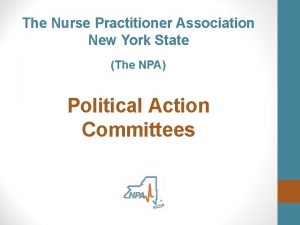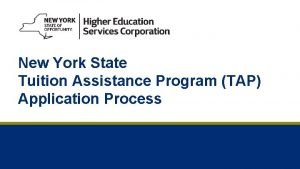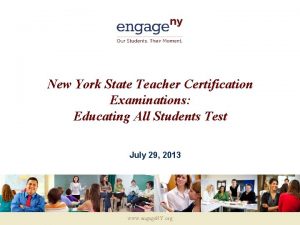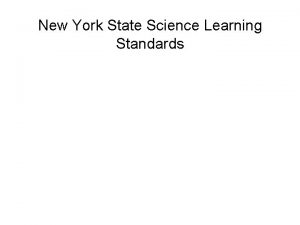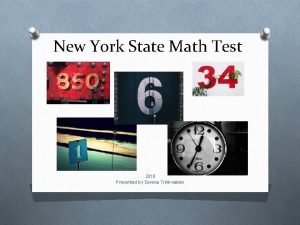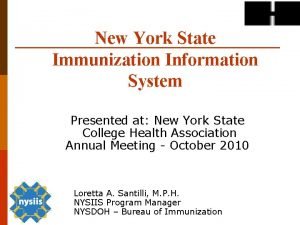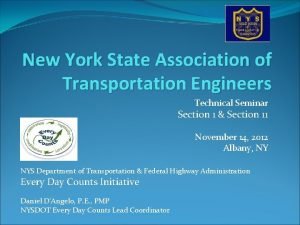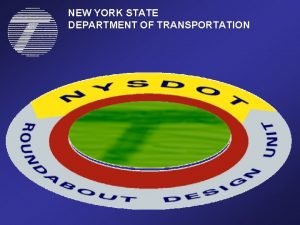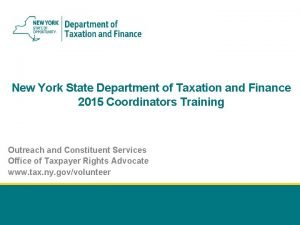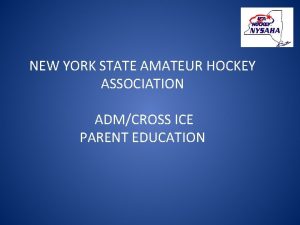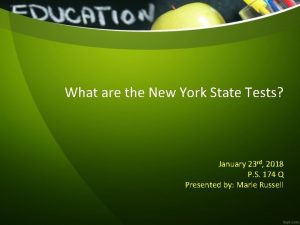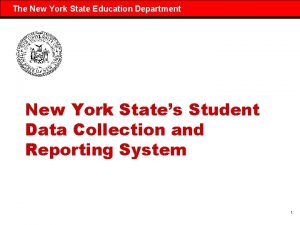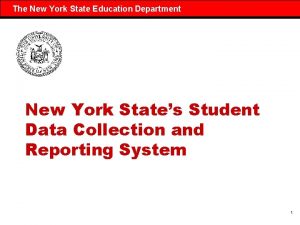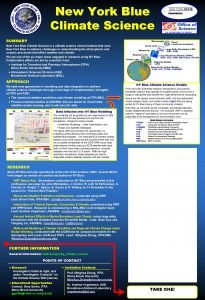What are the New York State Tests January




























- Slides: 28

What are the New York State Tests? January 21 st, 2020 PS 174 William Sidney Mount Presented by: Marie Russell MRussell 3@schools. nyc. gov

State Test Information: Students • Students in third through fifth grade will take the NYS ELA and Mathematics Assessments • Certain English Language Learners are exempt from the NYS ELA. If you have questions about an exemption please contact your child’s classroom or ELL teacher • Fourth grade students will take the NYS Science Assessment. A future workshop will be held to provide additional information

State Test Information: Dates • ELA – Wednesday, March 25 th & Thursday, March 26 th • Math – Wednesday, April 22 nd & Thursday, April 23 rd – Spring Recess: April 9 th-April 17 th (please avoid extending your family vacation beyond these dates).

NYS ELA Tests • Tests are untimed • Students will be provided with as much time as necessary to complete each test session within regular school hours • Students may work for as long as they need, as long as they are working productively • On average, students in grades 3– 4 will likely need approximately 60– 70 minutes of working time to complete Session 1 and 70– 80 minutes of working time to complete Session 2 • Students in grades 5– 8 will likely need approximately 80– 90 minutes of working time to complete Session 1 and 70– 80 minutes of working time to complete Session 2 • If students are still working, but most of their class has completed the test, they may be relocated to another room to finish

Types of Questions - ELA Designed to assess Reading and Language Standards • Ask students to analyze different aspects of a given text, including central idea, style elements, character and plot development, and vocabulary. • Almost all questions, including vocabulary questions, will only be answered correctly if the student comprehends and makes use of the whole passage. • Require more than rote recall or identification. • Students will also be required to negotiate plausible, text-based distractors. Multiple Choice Questions (1 point)

• Students use textual evidence to support their own answers to an inferential question. • Ask the student to make an inference (a claim, position, or conclusion) based on their analysis of the passage, state it in their own words, and then provide two pieces of text-based evidence to support their answer. • Assesses a student’s ability to comprehend analyze text. • Students will be expected to write in complete sentences. • Responses should typically require no more than three or four complete sentences. • It is important to note that students who answer the question only using details from the text will NOT receive full credit. • A full-credit response is characterized by both a valid inference and sufficient textual support. Shortresponse Questions (2 points)

• Assesses Writing from Sources. They will focus primarily on Writing Standards. • Grade 3 - requires comprehension and analysis of an individual text. • Grades 4– 8 - requires students to read analyze paired texts. Paired texts are related by theme, genre, tone, time period, or other characteristics. • Many extended- response questions will ask students to express a position and support it with text-based details. • Allow students to demonstrate their ability to write a coherent essay using textual evidence to support their ideas. • Responses will be evaluated based on Writing Standards and a student’s command of evidence to defend their point. Extended Response (4 points)

2020 Grades 3– 5 English Language Arts Tests Length of Texts Grade 3 500– 600 words Grade 4 600– 700 words Grade 5 700– 800 words

• Types of Informational Texts:

3 rd & 4 th Grade Format 2020 Grades 3– 4 English Language Arts Test Design Session 1 Session 2 Total Reading Writing Passages 4 3 7 Multiple-Choice Questions 24 0 24 Short-Response Questions 0 6 6 Extended-Response Questions 0 1 1 Total Number of Literary Passages 3– 4 Total Number of Informational Passages 3– 4

5 th Grade Format 2020 Grades 5– 6 English Language Arts Test Design Session 1 Session 2 Total Reading Writing Passages 5 3 8 Multiple-Choice Questions 35 0 35 Short-Response Questions 0 6 6 Extended-Response Questions 0 1 1 Total Number of Literary Passages 3– 5 Total Number of Informational Passages 3– 5

Advice for Students - ELA

Sample Multiple Choice Question In paragraph 9, what is the most likely reason Riley stays quiet as she and Craig walk home? 1. A She is thinking about how well she played hockey. 2. B She is upset with Craig because he hurt her back. 3. C She is thinking about how to get skates for Craig. 4. D She is tired from skating in the hockey game. 2019 -released-items-ela-g 3. pdf

Sample Short Answer Question 2019 -released-items-ela-g 4. pdf

Sample Extended Response Question 2019 -released-items-ela-g 5. pdf

NYS Math Tests • Tests are untimed • Students will be provided with as much time as necessary to complete each test session within regular school hours • Students may work for as long as they need, as long as they are working productively • Students in grade 3 will likely need approximately 55 -65 minutes of working time to complete Session 1 and 60– 70 minutes of working time to complete Session 2 • Students in grade 4 will likely need approximately 65 -75 minutes of working time to complete Session 1 and 65– 75 minutes of working time to complete Session 2 • Students in grade 5 will likely need approximately 80– 90 minutes of working time to complete Session 1 and 70– 80 minutes of working time to complete Session 2 • If students are still working, but most of their class has completed the test, they may be relocated to another room to finish

Types of Questions - Math Some test questions target more than one standard or assess an entire cluster. As such, Multiple-Choice (1 -point) Students select the correct response from four answer choices. Many multiple-choice qu

Types of Questions - Math cont. If students are directed to show work or provide an explanation, a correct answer with no work shown or no explanation provided receives no credit. Short-response (2 -points) Short-response questions require students to complete a task and show their work. Like multiple-choice questions, short-response questions will often require multiple steps, the application of multiple mathematics skills, and realworld applications. Extended-response (3 -points) Extended-response questions ask students to show their work in completing two or more tasks or a more extensive problem. Extended-response questions allow students to show their understanding of mathematical procedures, conceptual understanding, and application. Extended-response questions may also assess student reasoning and the ability to critique the arguments of others.

Mathematics Test Format 2020 Grade 3 Test Design Number of Multiple- Number of Short- Number of Extended- Total Number of Choice Questions Response Questions 1 25 0 0 25 2 8 Session Total Session 33 Number of Multiple- 6 1 2020 Grades 4 and 5 Test Design 6 1 Number of Short- Number of Extended- 15 40 Total Number of Choice Questions Response Questions 1 30 0 0 30 2 8 6 1 15 Total 38 6 1 45

Advice for Students - Mathematics

Mathematical Tools No Calculators. Students are provided with the following materials for the test: 3 rd Grade - Ruler 4 th Grade - Ruler & Protractor 5 th Grade - Ruler, Protractor & Reference Sheet

• Multiple choice Sample Math Question Sample from 3 rd grade NYS released questions - 2019

Sample Math Question • Short Answer Sample from 4 th grade NYS released questions - 2019

Sample Math Question Extended Response Sample from 5 th grade NYS released questions - 2019

Ways to Help Your Child at Home • Provide a quiet space for homework. Make sure supplies are available – paper, scissors, glue, crayons, pencils, etc. • Set up routines and reinforce good habits – homework time, reading time, etc. • Oversee technology - limit social media, gaming, and Youtube. • Encourage your child to read to you - have books and magazines around the house. • Visit your local library - borrow books and magazines in different genres. • Be a good listener – ask your child about the activities they are doing at school. • Reinforce the skills and concepts your child is learning at school, e. g. math skills through cooking and shopping, writing notes, etc. • Give your child as many different experiences as possible – take trips to museums, the zoo, shows, etc.

Test Taking Tips Do not put undue pressure on your child Make sure they get a good night’s sleep Make sure they eat breakfast the day of the test Do not send your child to take the test if they are not feeling well (there are makeup days) • Your child should bring three sharpened #2 pencils with erasers, but no “lucky pencils” or “special erasers” as they can be a distraction • Let them know that once the test is over, it is a normal day and the test is just a small part of that day • •

Links • https: //www. engageny. org/resource/released-2019 -3 -8 -elaand-mathematics-state-test-questions • http: //www. p 12. nysed. gov/assessment/ei/2019 -faqfor-parents-3 -8 -tests. pdf • http: //mc-14193 -39844713. us-east 1. elb. amazonaws. com/parent-and-family-resources • https: //www. engageny. org/videos-for-parents • http: //ps 174. org

PS 174 Philosophy on Testing: It’s just another day to show what you know!
 Antigentest åre
Antigentest åre Ace different help iq tests still
Ace different help iq tests still New york state nurse practitioner association
New york state nurse practitioner association Tap application
Tap application New york state teacher certification exams
New york state teacher certification exams New york state standards science
New york state standards science Nys math test 2018
Nys math test 2018 New york mesonet
New york mesonet State vegetable of new york
State vegetable of new york Gigp 30
Gigp 30 New york state professional firefighters association
New york state professional firefighters association Nysiis training
Nysiis training New york state association of transportation engineers
New york state association of transportation engineers Nys industries for the disabled
Nys industries for the disabled Department of criminal justice services ny
Department of criminal justice services ny New york state reliability council
New york state reliability council Nysdot hdm
Nysdot hdm What is nytprin
What is nytprin New york state nurse practitioner scope of practice
New york state nurse practitioner scope of practice New york state fish
New york state fish New york state nickname
New york state nickname New york state medicaid prior authorization
New york state medicaid prior authorization New york state amateur hockey association
New york state amateur hockey association New york state county highway superintendents association
New york state county highway superintendents association New york pennsylvania new jersey delaware
New york pennsylvania new jersey delaware Marquee new hartford
Marquee new hartford Strengths and weaknesses of the articles of confederation
Strengths and weaknesses of the articles of confederation Neil thisse is a loyalist answers
Neil thisse is a loyalist answers William lloyd garrison the hand of improvidence
William lloyd garrison the hand of improvidence


